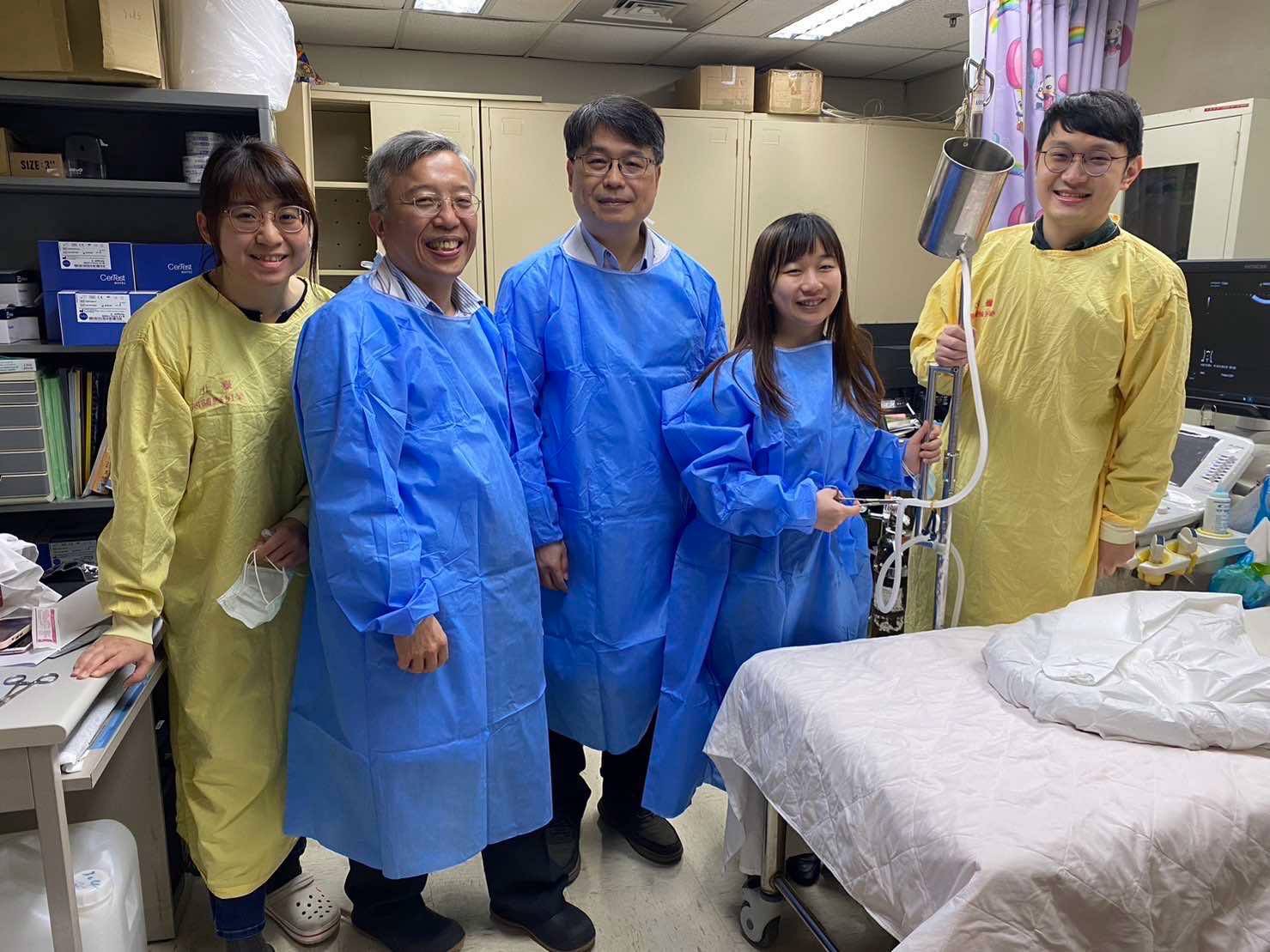The Pediatric Gastroenterology Department at Taipei Veterans General Hospital
We provide family-centered, personalized treatment plans and specialized care for acute, severe, complex, and rare diseases. Our team manages various gastrointestinal, hepatobiliary, and pancreatic conditions for pediatric outpatients and inpatients, including acute and chronic diarrhea, abdominal pain, constipation, gastrointestinal bleeding, Helicobacter pylori infection, inflammatory bowel disease (IBD), esophageal and gastrointestinal motility disorders, abdominal tumors, and a wide range of liver and biliary diseases such as acute and chronic hepatitis, fatty liver related to metabolic disorders, biliary atresia, choledochal cysts, gallstones, hepatobiliary tumors, pancreatic diseases, and other digestive conditions.
We also address nutrition-related issues and diseases such as pediatric and adolescent obesity, growth retardation, infant formula and complementary feeding choices, feeding difficulties, and pediatric nutrition consultation. Moreover, our department is committed to clinical and basic research in pediatric gastroenterology, hepatology, and nutrition, and we provide high-quality training programs to cultivate future experts in pediatric gastroenterology, thereby sustaining our mission to safeguard children's health and fulfill our medical and social responsibilities.

Specialized Examinations Offered:
Pediatric Abdominal Ultrasound
We have a dedicated pediatric ultrasound suite. This non-invasive tool assists in diagnosing various common gastrointestinal and liver conditions such as abdominal pain, fatty liver, and abnormal liver function. It also enables real-time diagnosis of acute abdominal conditions like intussusception, appendicitis, peritonitis, intra-abdominal abscesses, and abdominal tumors.
The procedure is painless and safe, and the comfortable environment allows children to complete the exam in a relaxed state. In most cases, the exam can be arranged during the same clinic visit, with imaging results and a physician's explanation provided on the same day—offering a comprehensive one-stop care experience.
Pediatric Gastrointestinal Endoscopy
Although endoscopy is an invasive procedure, collaboration with the anesthesia team ensures a painless experience throughout, helping children feel safe during treatment.
We offer a variety of endoscopic services, including diagnostic procedures (gastroscopy, colonoscopy, enteroscopy, and capsule endoscopy) and therapeutic interventions such as H. pylori testing, biopsy, esophageal variceal ligation, foreign body removal, polyp or tumor resection, and various hemostatic treatments.
24-Hour Esophageal pH Monitoring
A pH probe is inserted through the nostril to continuously record esophageal acidity for 24 hours while the patient maintains normal diet and activities. This is a highly accurate test for diagnosing gastroesophageal reflux disease (GERD).
Hydrogen Breath Test
After ingesting lactulose or glucose, the patient blows into a device every 20 minutes until the test is complete. This non-invasive test helps diagnose small intestinal bacterial overgrowth (SIBO), which can cause bloating, abdominal pain, and chronic diarrhea.
Gastrointestinal Pathogen Testing
Rapid detection of important pathogens such as rotavirus, adenovirus, and Clostridioides difficile. Testing can be performed immediately with fresh stool samples.
Gut Microbiome Analysis (Self-Paid Service)
Gut microbiota imbalance (dysbiosis) is associated with many gastrointestinal and metabolic diseases. We use next-generation sequencing to analyze the composition of the gut microbiota and provide personalized recommendations for gut health based on the results.
Integrated Diagnosis and Treatment for Pediatric and Adolescent Obesity and Fatty Liver (Led by Dr. Yu-Cheng Lin)
We assess obesity risk in children and adolescents using age- and gender-specific BMI percentiles according to Ministry of Health and Welfare guidelines. Based on individual risk, we recommend targeted examinations to detect potential comorbidities early and design personalized weight management plans.
Multidisciplinary Collaborative Care:
-
The Department of Medical Imaging and Nuclear Medicine provides gastrointestinal series, cholangiopancreatography, abdominal CT, MRI, and gastrointestinal bleeding detection and treatment.
-
The Division of Gastroenterology and Hepatology offers the C13 urea breath test and liver elastography.
-
The Department of Nutrition offers counseling for abnormal body weight (obesity, growth retardation), inpatient/outpatient nutritional assessment, and enteral nutrition therapy.
-
The Division of Genetics and Endocrinology conducts advanced exome and whole-genome sequencing to enhance genetic diagnosis of complex and rare pediatric GI and hepatobiliary conditions.
-
In collaboration with Pediatric Surgery, we provide rectal suction biopsy for Hirschsprung’s disease diagnosis, pediatric percutaneous endoscopic gastrostomy, and various hepatobiliary, pancreatic, and gastrointestinal surgeries. Our hospital’s excellent surgical techniques and postoperative care benefit many children requiring liver transplantation due to chronic liver disease or congenital metabolic disorders.
When to Consult Pediatric Gastroenterology:
-
Guidance on breastfeeding, infant formula, therapeutic formulas, complementary feeding, and proper nutrition for infants and children.
-
Suspected milk protein or food allergies (symptoms like vomiting, colic, diarrhea, blood in stool after formula or allergenic food).
-
Infantile colic (persistent crying, especially in the evening or at night).
-
Infant regurgitation or vomiting (e.g., GERD, hypertrophic pyloric stenosis).
-
Abdominal bloating and constipation in infants (e.g., Hirschsprung’s disease, intestinal motility disorders).
-
Defecation difficulties (anal fissure, hard stools, infrequent bowel movements).
-
Prolonged jaundice beyond 14 days after birth.
-
Jaundice or pale/gray stools (e.g., biliary atresia, neonatal cholestasis).
-
Growth retardation, protein-energy malnutrition, underweight, and picky eating.
-
Pediatric and adolescent obesity and fatty liver.
-
Acute gastroenteritis (vomiting, abdominal pain, diarrhea, fever).
-
Chronic diarrhea (post-infectious syndrome, severe malnutrition).
-
Acute abdominal pain (intussusception, appendicitis, incarcerated hernia, pancreatitis).
-
Chronic abdominal pain (severe constipation, IBS, chronic gastritis, duodenitis, Henoch-Schönlein purpura).
-
Peptic ulcers (H. pylori infection, gastric and duodenal ulcers).
-
Hematemesis and melena (upper GI bleeding), hematochezia (lower GI bleeding).
-
Hepatobiliary diseases (viral hepatitis, choledochal cysts, gallstones, Wilson’s disease, autoimmune hepatitis).
Last Modified: